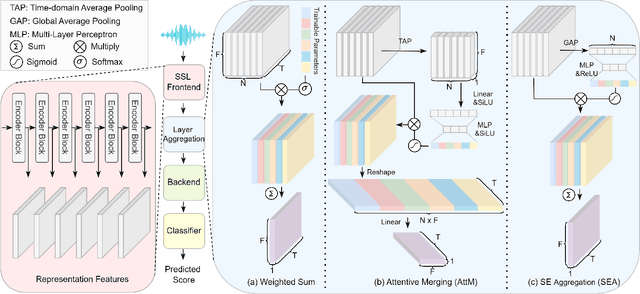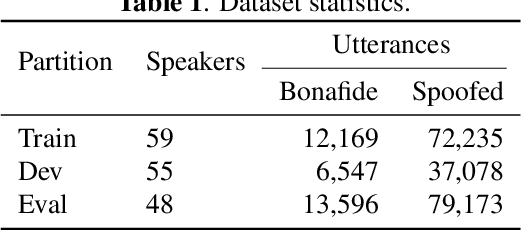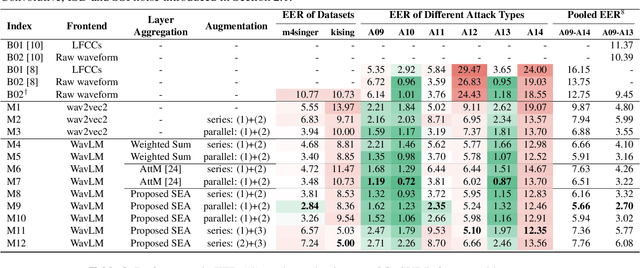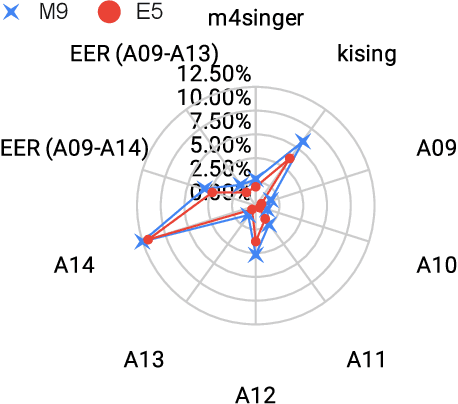Tianchi Liu
Nes2Net: A Lightweight Nested Architecture for Foundation Model Driven Speech Anti-spoofing
Apr 08, 2025Abstract:Speech foundation models have significantly advanced various speech-related tasks by providing exceptional representation capabilities. However, their high-dimensional output features often create a mismatch with downstream task models, which typically require lower-dimensional inputs. A common solution is to apply a dimensionality reduction (DR) layer, but this approach increases parameter overhead, computational costs, and risks losing valuable information. To address these issues, we propose Nested Res2Net (Nes2Net), a lightweight back-end architecture designed to directly process high-dimensional features without DR layers. The nested structure enhances multi-scale feature extraction, improves feature interaction, and preserves high-dimensional information. We first validate Nes2Net on CtrSVDD, a singing voice deepfake detection dataset, and report a 22% performance improvement and an 87% back-end computational cost reduction over the state-of-the-art baseline. Additionally, extensive testing across four diverse datasets: ASVspoof 2021, ASVspoof 5, PartialSpoof, and In-the-Wild, covering fully spoofed speech, adversarial attacks, partial spoofing, and real-world scenarios, consistently highlights Nes2Net's superior robustness and generalization capabilities. The code package and pre-trained models are available at https://github.com/Liu-Tianchi/Nes2Net.
Audio-FLAN: A Preliminary Release
Feb 23, 2025Abstract:Recent advancements in audio tokenization have significantly enhanced the integration of audio capabilities into large language models (LLMs). However, audio understanding and generation are often treated as distinct tasks, hindering the development of truly unified audio-language models. While instruction tuning has demonstrated remarkable success in improving generalization and zero-shot learning across text and vision, its application to audio remains largely unexplored. A major obstacle is the lack of comprehensive datasets that unify audio understanding and generation. To address this, we introduce Audio-FLAN, a large-scale instruction-tuning dataset covering 80 diverse tasks across speech, music, and sound domains, with over 100 million instances. Audio-FLAN lays the foundation for unified audio-language models that can seamlessly handle both understanding (e.g., transcription, comprehension) and generation (e.g., speech, music, sound) tasks across a wide range of audio domains in a zero-shot manner. The Audio-FLAN dataset is available on HuggingFace and GitHub and will be continuously updated.
ExPO: Explainable Phonetic Trait-Oriented Network for Speaker Verification
Jan 14, 2025



Abstract:In speaker verification, we use computational method to verify if an utterance matches the identity of an enrolled speaker. This task is similar to the manual task of forensic voice comparison, where linguistic analysis is combined with auditory measurements to compare and evaluate voice samples. Despite much success, we have yet to develop a speaker verification system that offers explainable results comparable to those from manual forensic voice comparison. A novel approach, Explainable Phonetic Trait-Oriented (ExPO) network, is proposed in this paper to introduce the speaker's phonetic trait which describes the speaker's characteristics at the phonetic level, resembling what forensic comparison does. ExPO not only generates utterance-level speaker embeddings but also allows for fine-grained analysis and visualization of phonetic traits, offering an explainable speaker verification process. Furthermore, we investigate phonetic traits from within-speaker and between-speaker variation perspectives to determine which trait is most effective for speaker verification, marking an important step towards explainable speaker verification. Our code is available at https://github.com/mmmmayi/ExPO.
MERaLiON-SpeechEncoder: Towards a Speech Foundation Model for Singapore and Beyond
Dec 20, 2024Abstract:This technical report describes the MERaLiON-SpeechEncoder, a foundation model designed to support a wide range of downstream speech applications. Developed as part of Singapore's National Multimodal Large Language Model Programme, the MERaLiON-SpeechEncoder is tailored to address the speech processing needs in Singapore and the surrounding Southeast Asian region. The model currently supports mainly English, including the variety spoken in Singapore. We are actively expanding our datasets to gradually cover other languages in subsequent releases. The MERaLiON-SpeechEncoder was pre-trained from scratch on 200,000 hours of unlabelled speech data using a self-supervised learning approach based on masked language modelling. We describe our training procedure and hyperparameter tuning experiments in detail below. Our evaluation demonstrates improvements to spontaneous and Singapore speech benchmarks for speech recognition, while remaining competitive to other state-of-the-art speech encoders across ten other speech tasks. We commit to releasing our model, supporting broader research endeavours, both in Singapore and beyond.
Towards a Speech Foundation Model for Singapore and Beyond
Dec 16, 2024Abstract:This technical report describes the MERaLiON Speech Encoder, a foundation model designed to support a wide range of downstream speech applications. Developed as part of Singapore's National Multimodal Large Language Model Programme, the MERaLiON Speech Encoder is tailored to address the speech processing needs in Singapore and the surrounding Southeast Asian region. The model currently supports mainly English, including the variety spoken in Singapore. We are actively expanding our datasets to gradually cover other languages in subsequent releases. The MERaLiON Speech Encoder was pre-trained from scratch on 200K hours of unlabelled speech data using a self-supervised learning approach based on masked language modelling. We describe our training procedure and hyperparameter tuning experiments in detail below. Our evaluation demonstrates improvements to spontaneous and Singapore speech benchmarks for speech recognition, while remaining competitive to other state-of-the-art speech encoders across ten other speech tasks. We commit to releasing our model, supporting broader research endeavours, both in Singapore and beyond.
Towards Quantifying and Reducing Language Mismatch Effects in Cross-Lingual Speech Anti-Spoofing
Sep 12, 2024Abstract:The effects of language mismatch impact speech anti-spoofing systems, while investigations and quantification of these effects remain limited. Existing anti-spoofing datasets are mainly in English, and the high cost of acquiring multilingual datasets hinders training language-independent models. We initiate this work by evaluating top-performing speech anti-spoofing systems that are trained on English data but tested on other languages, observing notable performance declines. We propose an innovative approach - Accent-based data expansion via TTS (ACCENT), which introduces diverse linguistic knowledge to monolingual-trained models, improving their cross-lingual capabilities. We conduct experiments on a large-scale dataset consisting of over 3 million samples, including 1.8 million training samples and nearly 1.2 million testing samples across 12 languages. The language mismatch effects are preliminarily quantified and remarkably reduced over 15% by applying the proposed ACCENT. This easily implementable method shows promise for multilingual and low-resource language scenarios.
Speech Foundation Model Ensembles for the Controlled Singing Voice Deepfake Detection (CtrSVDD) Challenge 2024
Sep 03, 2024



Abstract:This work details our approach to achieving a leading system with a 1.79% pooled equal error rate (EER) on the evaluation set of the Controlled Singing Voice Deepfake Detection (CtrSVDD). The rapid advancement of generative AI models presents significant challenges for detecting AI-generated deepfake singing voices, attracting increased research attention. The Singing Voice Deepfake Detection (SVDD) Challenge 2024 aims to address this complex task. In this work, we explore the ensemble methods, utilizing speech foundation models to develop robust singing voice anti-spoofing systems. We also introduce a novel Squeeze-and-Excitation Aggregation (SEA) method, which efficiently and effectively integrates representation features from the speech foundation models, surpassing the performance of our other individual systems. Evaluation results confirm the efficacy of our approach in detecting deepfake singing voices. The codes can be accessed at https://github.com/Anmol2059/SVDD2024.
Attentive Merging of Hidden Embeddings from Pre-trained Speech Model for Anti-spoofing Detection
Jun 12, 2024Abstract:Self-supervised learning (SSL) speech representation models, trained on large speech corpora, have demonstrated effectiveness in extracting hierarchical speech embeddings through multiple transformer layers. However, the behavior of these embeddings in specific tasks remains uncertain. This paper investigates the multi-layer behavior of the WavLM model in anti-spoofing and proposes an attentive merging method to leverage the hierarchical hidden embeddings. Results demonstrate the feasibility of fine-tuning WavLM to achieve the best equal error rate (EER) of 0.65%, 3.50%, and 3.19% on the ASVspoof 2019LA, 2021LA, and 2021DF evaluation sets, respectively. Notably, We find that the early hidden transformer layers of the WavLM large model contribute significantly to anti-spoofing task, enabling computational efficiency by utilizing a partial pre-trained model.
How Do Neural Spoofing Countermeasures Detect Partially Spoofed Audio?
Jun 04, 2024Abstract:Partially manipulating a sentence can greatly change its meaning. Recent work shows that countermeasures (CMs) trained on partially spoofed audio can effectively detect such spoofing. However, the current understanding of the decision-making process of CMs is limited. We utilize Grad-CAM and introduce a quantitative analysis metric to interpret CMs' decisions. We find that CMs prioritize the artifacts of transition regions created when concatenating bona fide and spoofed audio. This focus differs from that of CMs trained on fully spoofed audio, which concentrate on the pattern differences between bona fide and spoofed parts. Our further investigation explains the varying nature of CMs' focus while making correct or incorrect predictions. These insights provide a basis for the design of CM models and the creation of datasets. Moreover, this work lays a foundation of interpretability in the field of partial spoofed audio detection that has not been well explored previously.
Voice Conversion Augmentation for Speaker Recognition on Defective Datasets
Apr 01, 2024Abstract:Modern speaker recognition system relies on abundant and balanced datasets for classification training. However, diverse defective datasets, such as partially-labelled, small-scale, and imbalanced datasets, are common in real-world applications. Previous works usually studied specific solutions for each scenario from the algorithm perspective. However, the root cause of these problems lies in dataset imperfections. To address these challenges with a unified solution, we propose the Voice Conversion Augmentation (VCA) strategy to obtain pseudo speech from the training set. Furthermore, to guarantee generation quality, we designed the VCA-NN~(nearest neighbours) strategy to select source speech from utterances that are close to the target speech in the representation space. Our experimental results on three created datasets demonstrated that VCA-NN effectively mitigates these dataset problems, which provides a new direction for handling the speaker recognition problems from the data aspect.
 Add to Chrome
Add to Chrome Add to Firefox
Add to Firefox Add to Edge
Add to Edge